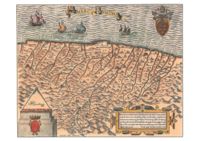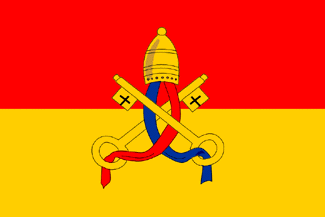
March of Ancona
Encyclopedia


Marches
A march or mark refers to a border region similar to a frontier, such as the Welsh Marches, the borderland between England and Wales. During the Frankish Carolingian Dynasty, the word spread throughout Europe....
centred on the city of Ancona
Ancona
Ancona is a city and a seaport in the Marche region, in central Italy, with a population of 101,909 . Ancona is the capital of the province of Ancona and of the region....
and, then, Macerata
Macerata
Macerata is a city and comune in central Italy, the capital of the province of Macerata in the Marche region.The historical city center is located on a hill between the Chienti and Potenza rivers. It consisted of the Picenes city named Ricina, then, after the romanization, Recina and Helvia Recina...
in the Middle Ages
Middle Ages
The Middle Ages is a periodization of European history from the 5th century to the 15th century. The Middle Ages follows the fall of the Western Roman Empire in 476 and precedes the Early Modern Era. It is the middle period of a three-period division of Western history: Classic, Medieval and Modern...
. Its name is preserved as an Italian region today, the Marche
Marche
The population density in the region is below the national average. In 2008, it was 161.5 inhabitants per km2, compared to the national figure of 198.8. It is highest in the province of Ancona , and lowest in the province of Macerata...
, and it corresponds to almost the entire modern region and not just the Province of Ancona
Province of Ancona
The Province of Ancona is a province in the Marche region of central Italy. Its capital is the city of Ancona. The province has an area of 1940 km² and a 2006 population of 465,906 in 49 comuni , see Comunes of the Province of Ancona....
.
The march was created as a political division of the Papal States
Papal States
The Papal State, State of the Church, or Pontifical States were among the major historical states of Italy from roughly the 6th century until the Italian peninsula was unified in 1861 by the Kingdom of Piedmont-Sardinia .The Papal States comprised territories under...
during the pontificate of Innocent III in the year 1198. It was initially governed by a papal nominee called a rector
Rector
The word rector has a number of different meanings; it is widely used to refer to an academic, religious or political administrator...
. The rector of Ancona, like the rectors of the other papal provinces, was under the authority of a general rector reporting directly to the pope. The province was confirmed by the Constitutiones Sanctæ Matris Ecclesiæ
Constitutiones Sanctæ Matris Ecclesiæ
The Constitutiones Sanctæ Matris Ecclesiæ , informally known as the Constitutiones Aegidianae , were six books of law which formed the first historic constitution of the Papal States...
in 1357. The march followed the Adriatic as far north as Urbino
Urbino
Urbino is a walled city in the Marche region of Italy, south-west of Pesaro, a World Heritage Site notable for a remarkable historical legacy of independent Renaissance culture, especially under the patronage of Federico da Montefeltro, duke of Urbino from 1444 to 1482...
and contained the cities of Loreto
Loreto (AN)
Loreto is a hilltown and comune of the Italian province of Ancona, in the Marche. It is mostly famous as the seat of the Basilica della Santa Casa, a popular Catholic pilgrimage site.-Location:...
, Camerino
Camerino
Camerino is a small town of 7.135 inhabitants in the Marches , in the province of Macerata, Italy. It is located in the Apennines bordering Umbria, between the valleys of the rivers Potenza and Chienti, about 40 miles from Ancona....
, Fermo
Fermo
Fermo is a town and comune of the Marche, Italy, in the Province of Fermo.Fermo is located on a hill, the Sabulo with a fine view, on a branch from Porto San Giorgio on the Adriatic coast railway....
, Macerata
Macerata
Macerata is a city and comune in central Italy, the capital of the province of Macerata in the Marche region.The historical city center is located on a hill between the Chienti and Potenza rivers. It consisted of the Picenes city named Ricina, then, after the romanization, Recina and Helvia Recina...
, Osimo
Osimo
Osimo is a town and comune of the Marche, Italy, in the province of Ancona, 15 km south of that town by rail. It is situated on a hill near the Adriatic Sea.Silk-spinning and the raising of cocoons are carried on.-History:...
, San Severino
San Severino
-Places in Italy:*Mercato San Severino, a commune of the Province of Salerno*San Severino Lucano, a commune of the Province of Potenza*San Severino Marche, a commune in the Province of Macerata*San Severino, an hamlet of Centola in the Province of Salerno...
, and Tolentino
Tolentino
Tolentino is a town and comune of about 20,000 inhabitants, in the province of Macerata in the Marche region of central Italy.It is located in the middle of the valley of the Chienti.-History:...
The March and the Spiritual Franciscans
According to Paul Sabatier's biography of St. Francis of Assisi, "The Road to Assisi", the March of Ancona became the home of the spiritual Franciscans after Francis' death. These included some of Francis' original disciples, most notably Brother Bernard of Quintavalle, who was Francis' first convert and companion, and Brother Thomas of Celano, who wrote the official hagiographies that brought Francis to canonization.
These "spirituals" were unhappy with the Rules of 1221 and 1223 adopted by the Order of Friars Minor after Francis abdicated leadership of the Order. The Marches provided room for the solitude and poverty they sought. The region also offered protection from the authorities (Papal, Franciscan, and secular) who dubbed them 'heretics'.

